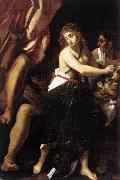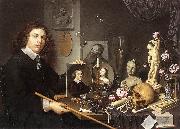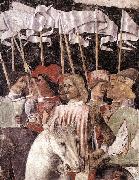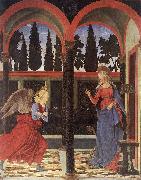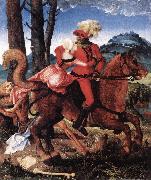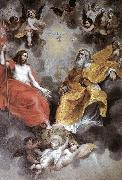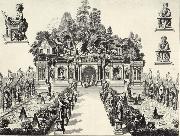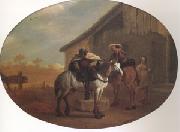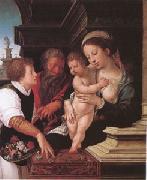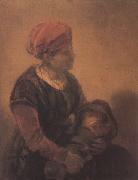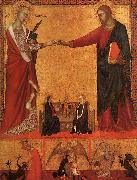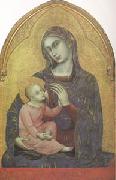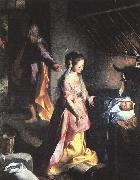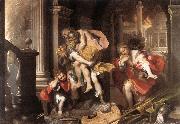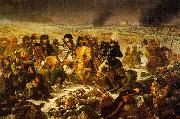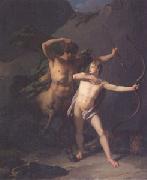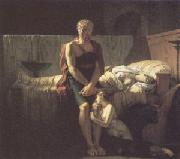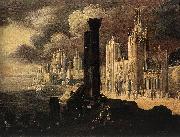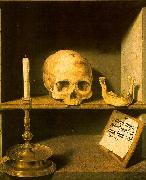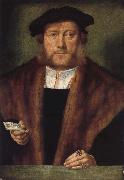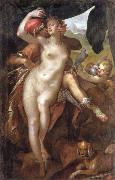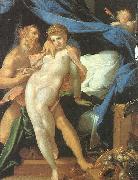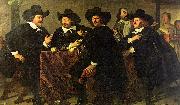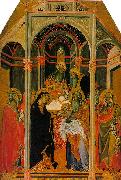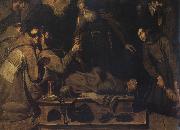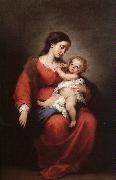|
|
|
|
|
|
|
|
|
|
 |
Baldassarre Peruzzi
|
|
(7 March 1481 - 6 January 1536) was an Italian architect and painter, born in a small town near Siena and died in Rome. He worked for many years, beginning in 1520, under Bramante, Raphael, and later Sangallo during the erection of the new St. Peter's. He returned to his native Siena after the Sack of Rome (1527) where he was employed as architect to the Republic. For the Sienese he built new fortifications for the city and designed (though did not build) a remarkable dam on the Bruna River near Giuncarico. He seems to have moved back to Rome by 1535.
He was a painter of frescoes in the Cappella San Giovanni in the Duomo of Siena.
His son Giovanni Sallustio was also an architect.
|
|
|
|
 |
Baldung
|
|
b.c. 1484, Schwäbisch Gm??nd, W??rttemberg [Germany]
d.1545, Imperial Free City of Strasbourg [now Strasbourg, Fr.]
Hans Baldung Gallery |
|
|
|
|
|
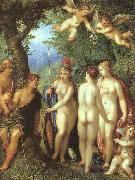 |
Balen, Hendrick von
|
|
Dutch, approx. 1575-1632
Hendrik van Balen
Students included Anthony Van Dyck, Frans Snyders and Gerard Seghers
|
|
|
|
 |
Balthasar Denner
|
|
(15 November 1685 in Altona - 14 April 1749 in Rostock) was a German painter, highly-regarded as a portraitist. He painted mostly half-length and head-and-shoulders portraits and a few group portraits of families in interiors. Usually Denner concentrated on the face; clothes and paraphernalia were done by other painters or later his daughter. |
|
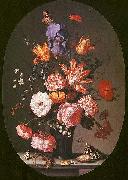 |
Balthasar van der Ast
|
|
(1593/94 - 1657) was a Dutch Golden Age painter who specialized in still lifes of flowers and fruit, as well as painting a number of remarkable shell still lifes; he is considered to be a pioneer in the genre of shell painting. His still lifes often contain insects and lizards. He was born in Middelburg and died at Delft.
|
|
|
|
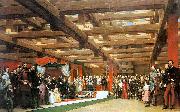 |
Barabas Miklos
|
|
(February 10, 1810 in Mărcuşa, now Romania - February 12, 1898 in Budapest) was a Hungarian painter. He his mostly known for his portrait paintings.
He was born in Kezdimerkosfalva. He spent most of his life in Pest, where he was director of the art society from 1862 until his death. He became a member of the Parliament of Hungary in 1867. He died in Budapest.
|
|
|
|
|
|
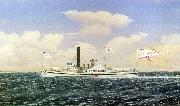 |
Bard, James
|
|
Specializes in Maritime Art
American Painter, 1815-1897 |
|
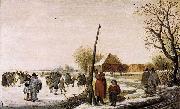 |
Barend Avercamp
|
|
(1612-1679) was a Dutch painter.
Avercamp was born in Kampen and was taught by his uncle Hendrick Avercamp, who was also a painter. Barent primarily painted scenes depicting Netherlands in winter. He was a member of the Guild of Saint Luke, and traveled around the Netherlands including Zwolle and Zutphen for his settings and inspiration.
|
|
|
|
|
|
|
|
|
|
|
|
|
|
|
|
|
|
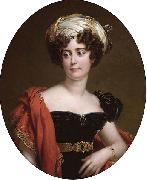 |
Baron Gerard
|
|
There have been three baronies created for descendants of the Gerard family who resided at Bryn, Ashton in Makerfield, Lancashire and Kingsley, Cheshire in the 13th century.
The title Baron Gerard of Gerards Bromley, was created in the Peerage of England on 21 July 1603 for Sir Thomas Gerard (d. 1617), son of Sir Gilbert Gerard (d. 1593) Attorney General between 1559 and 1581 and Master of the Rolls in 1581, who acquired estates at Gerards Bromley and Hilderstone, Staffordshire. The first Baron was Lord President of Wales between 1610 and 1617. The barony passed in direct line of succession until the death of the fifth Baron in 1684 when it passed to his second cousin Charles, and upon his death without a male heir , to his brother Philip Gerard, a Jesuit priest who died childless in 1773 when the barony expired.
The title of Baron Gerard of Bryn in the County Palatine of Lancaster, was created in the Peerage of the United Kingdom in 1876 for Sir Robert Gerard, 13th Baronet. The title followed the line of the first Baron's eldest son until the death of the latter's grandson, the fourth Baron, in 1992. He was succeeded by his second cousin once removed, the fifth and present holder of the barony. He is the great grandson of Captain the Hon. Robert Joseph Gerard-Dicconson, second son of the first Baron.
A Gerard Baronetcy had been created in the Baronetage of England in 1611 for Thomas Gerard, Member of Parliament for Liverpool, Lancashire, and Wigan who was a direct descendant of the family of Bryn. He was succeeded by his son, the second Baronet. He also represented Liverpool in the House of Commons. His son, the third Baronet, was a Royalist during the Civil War and spent a large part of his estate in in his support for King Charles I. His great-great-great-grandson was the aforementioned thirteenth Baronet, who was elevated to the peerage in 1876.
For the title Baron Gerard of Brandon, in the County of Suffolk, created in 1645 for a great-grandson of Sir Gilbert Gerard (mentioned above), see Earl of Macclesfield.
|
|
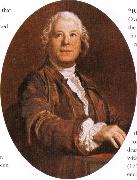 |
baron grimm
|
|
German critic. He worked as a diplomat in Paris from 1749. Influenced by the Encyclopedists, he favoured the use of the Italian style in French operas (especially those of Rameau, ', ', ', ', ', ', ', '); in the Querelle des Bouffons of the 1750s he rejected all French music in favour of Rousseau, writing the satirical tract Le petit proph??te de Boehmischbroda (1753) and other works. He was a friend to the visiting Mozart family, 1763-4 and 1778.
|
|
|
|
|
|
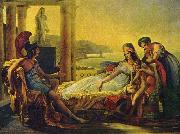 |
Baron Pierre-Narcisse Guerin
|
|
(13 May 1774 - 6 July 1833) was a French painter.
Guerin was born in Paris.
A pupil of Jean-Baptiste Regnault, he carried off one of the three grands prix offered in 1796, in consequence of the competition not having taken place since 1793. In 1799, his painting Marcus Sextus (Louvre) was exhibited at the Salon and excited wild enthusiasm. Part of this was due to the subject - a victim of Sulla's proscription returning to Rome to find his wife dead and his house in mourning - in which an allusion was found to the turmoil of the French Revolution.
Guerin on this occasion was publicly crowned by the president of the Institute, and went to Rome to study under Joseph-Benoît Suvee. In 1800, unable to remain in Rome on account of his health, he went to Naples, where he painted the Grave of Amyntas. In 1802 Guerin produced Phaedra and Hippolytus (Louvre); in 1810, after his return to Paris, he again achieved a great success with Andromache and Pyrrhus (Louvre); and in the same year also exhibited Cephalus and Aurora (Louvre) and Bonaparte and the Rebels of Cairo (Versailles). These paintings suited the popular taste of the First Empire, being highly melodramatic and pompously dignified.
The Restoration brought to Guerin fresh honours; he had received from the first consul in 1803 the cross of the Legion of Honour, and in 1815 Louis XVIII named to the Academie des Beaux-Arts. His style changed to accord with popular taste. In Aeneas Relating to Dido the Disasters of Troy (Louvre), Guerin adopted a more sensuous, picturesque style.
Guerin was commissioned to paint for the Madeleine a scene from the history of St Louis, but his health prevented him from accomplishing what he had begun, and in 1822 he accepted the post of director of the French Academy in Rome, which in 1816 he had refused. On returning to Paris in 1828, Guerin, who had previously been made chevalier of the order of St. Michel, was ennobled. He now attempted to complete Pyrrhus and Priam, a work which he had begun at Rome, but in vain; his health had finally broken down, and in the hope of improvement he returned to Italy with Horace Vernet. Shortly after his arrival at Rome Baron Guerin died, on the 6th of July 1833, and was buried in the church of La Trinite de Monti by the side of Claude Lorrain.
|
|
|
|
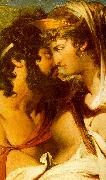 |
Barry, James
|
|
Dutch Baroque Era Painter, 1627-ca.1683
Studied under Otto Marseus van Schrieck.
Students included Rachel Ruysch.
|
|
|
|
|
|
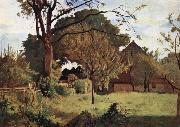 |
Barthelemy Menn
|
|
(20 May 1815 - 10 October 1893) was a Swiss painter and draughtsman who introduced the principles of plein-air painting and the paysage intime into Swiss art.
Menn was born in Geneva as the youngest son of four to Not (Rhaeto-Romance language form for Louis) Menn, a confectioner from Scuol in the canton of Grisons, and Charlotte-Madeleine-Marguerite Bodmer, the daughter of a wealthy farmer from Coinsins in the Canton de Vaud. Already at the age of twelve, Menn took drawing lessons from the little known Jean Duboi (1789-1849), and later, he entered the drawing school of the Geneva Arts Society. The repeated claim that he was also a pupil of the famous enameller Abraham Constantin (1785-1855) appears to be erroneous. In 1831, Menn was second in the annual drawing competition of the Geneva Art Society. The following year, he entered the studio of the Swiss history painter Jean-Leonard Lugardon (1801-1884), who was a pupil of Baron Gros(1771-1835) and acquainted with Jean-Auguste-Dominique Ingres (1780-1867). There, Menn was educated in figure drawing and composition before heading for Paris, where, in fall 1833, he entered the studio of Ingres. He was, therefore, no beginner when meeting the master, but needed some polishing and refinement in his art. In a letter to his friend Jules Hebert, Menn reported on the new situation: eEverybody, even the eldest in the studio tremble before Mr. Ingres. One fears him a lot in such a way that his corrections have a great impact. He is of an extreme sensibility,e while the education in Ingrese studio has been described by Theophile Silvestre, as follows: 'The students spend half of their time studying nature and half studying the masters among which they are especially attached to Phidias, the bas-reliefs of the Parthenon, classical sculpture in general.e This explains why among Menn's early works there are many copies after the Parthenon frieze that was accessible in Paris in a set of plaster casts at the Ecole des Beaux-Arts since 1816. (Fig. 2). Menn also copied several works by Raffael, Titian (Fig. 3), Veronese and Rubens in the Louvre, and works by Ingres.
When the latter decided to give up his studio to take the post as director of the French Academy in the Villa Medici in Rome, Menn returned to his grandparents in Coinsins before following his master in fall 1834. His journey led him first via Milan to Venice, where he met briefly his compatriot Louis-Leopold Robert (1798-1835), and where he would copy works by Titian and Tintoretto. He then travelled via Padua and Bologna to Florence, where he met old classmates from Ingrese studio, and arrived finally in Rome in spring 1835. There, Menn copied works by Raphael and Michelangelo, but he also started to produce extraordinary fresh small landscape paintings in the open air. In summer 1836, he visited the Campagna, Capri and Naples, where too he drew and painted landscapes directly from nature, and copied classical antiquities from Pompeii as well as Giovanni Bellini's Transfiguration in the Museo Borbonico. When back in Rome, he produced history - and genre paintings, of which in 1837, he sent 'Solomon presented to Wisdom by his Parents' (Salomon presente e la sagesse par son pere et sa mere; Fig.N) to the annual Salon in Geneva. Menn returned via Florence, Siena and Viterbo to Paris in late 1838, where he exhibited at the Salon from 1839 to 1843, and where he became the drawing master of Maurice Dudevant, the son of George Sand. In her circle, he became acquainted with Eugene Delacroix (1798-1863) who wanted to employ him as an assistant while working on the decoration of the cupola of the library in the Palais du Luxembourg. At the same time, Menn got to know the painters of the Barbizon School, and especially Charles Daubigny (1817-1878). Most importantly, however, Menn became friends with Camille Corot (1796-1875), who, from 1842 onwards, visited Switzerland frequently. It was also in Paris that he became acquainted with members of the Genevan Bovy family who followed the utopian socialist ideas of Charles Fourier.
|
|
|
|
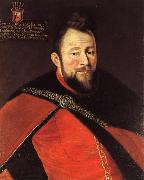 |
Bartholomaus Strobel
|
|
(Breslau 1591-1647 Thorn) was a German baroque painter from Silesia who worked in Poland.
He studied art in the studio of his father. He spent time in Vienna and in Prague. In 1633 he settled in Gdansk and in 1637 operated in Elbing, and thereafter in Torun.
According to Houbraken he received the Dutch painter Gillis Schagen in Elbing in 1637. Strobel was court painter to the emperor at that time, and later became court painter to Władysław IV Vasa, King of Poland.Schagen painted a portrait of the King of Poland to "prove his mastership of the art" for him.
According to the RKD he worked mostly in Prague.
He produced royal court paintings and paintings for the chapel of St.. Kaźmirza in Vilna, (1636-37), and religious paintings in Torue in 1634.
|
|
 |
Bartholomeus Breenbergh
|
|
(before 13 November 1598 - after 3 October 1657) was a Dutch painter born in Deventer.
Breenbergh established himself in Amsterdam and then in 1619 went to Rome. There he lived and worked with the Flemish painter Frans van de Kasteele and was heavily influenced by another Fleming, the landscape painter Paul Bril. From 1623, however, he came completely under the spell of Italian landscapes by the somewhat older Cornelis van Poelenburgheindeed, the works of Breenbergh and van Poelenburgh are sometimes very difficult of tell apart. Breenbergh in his turn influenced the French painter Claude Lorrain. Breenbergh was one of the founders of the Bentvueghels, where he was nicknamed "het fret".
In 1633 Breenbergh returned to Amsterdam, where he remained until his death, and where he made paintings and etchings of Italian buildings. There he was influenced by the pre-Rembrandtists such as Pieter Lastman and Nicolaes Moeyaert, but he placed their Biblical and mythological scenes in Italian landscapes.
|
|
|
|
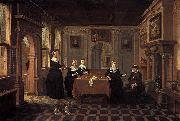 |
Bartholomeus van Bassen
|
|
(1590 - 1652) was a Dutch Golden Age painter and architect.
Van Bassen was born in Antwerp. Little is known of his early life, but according to the RKD he became a member of the Delft Guild of St. Luke in 1613. In 1622 he moved to the Hague, where he became a member of the The Hague Guild of St. Luke two years later and where he became dean in 1627 and headman in 1636 and 1640. He is known for his architectural works, sometimes with staffage by the painters Anthonie Palamedesz, Esaias van de Velde, and Jan Martszen de Jonge. |
|
|
|
|
|
|
|
|
|
|
|
 |
Bartolome Perez
|
|
(1634-1693) was a Spanish painter of the Baroque period.
Born in Madrid, he became the son-in-law and pupil of the painter Juan de Arellano. Known as a painter of flowers and still life, known as bodegones. He also painted scenography for performances at the theater of Buen Retiro, for which he was named painter of the King without salary in January of 1689. He died after falling from a scaffold used to paint the ceiling of the palace of Monteleon, and was buried in the church of San Ildefonso.
|
|
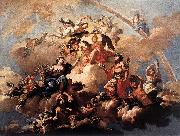 |
Bartolomeo Altomonte
|
|
Bartolomeo Altomonte, also known as Bartholomäus Hohenberg (24 February 1694 - 11 November 1783), was an Austrian baroque painter who specialized in large scale frescoes. He was the son of Martino Altomonte, also a painter. |
|
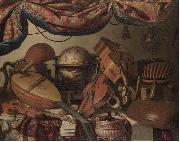 |
Bartolomeo Bettera
|
|
Bartolomeo Bettera (Bergame, 28 août 1639 - Milan, apres 1688) est un peintre italien qui a ete actif dans la seconde moitie du XVIIe sie-le dans la peinture de nature morte. |
|
|








